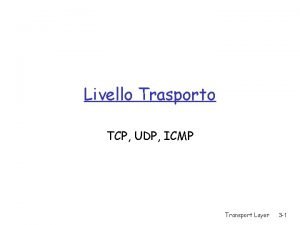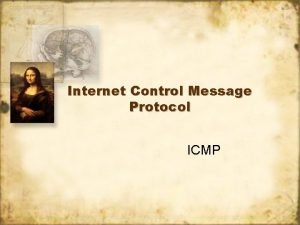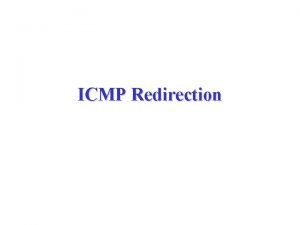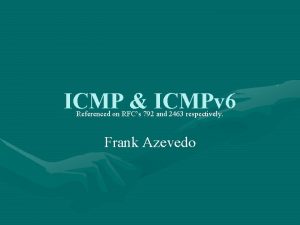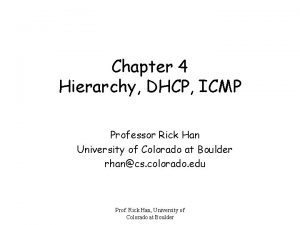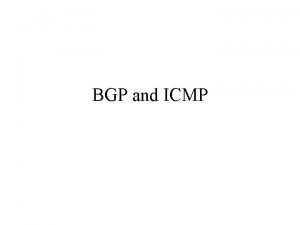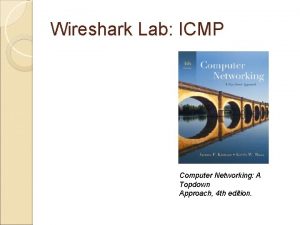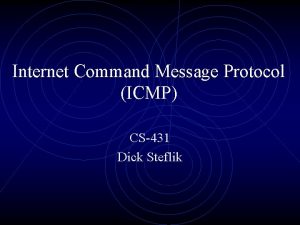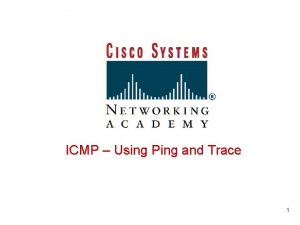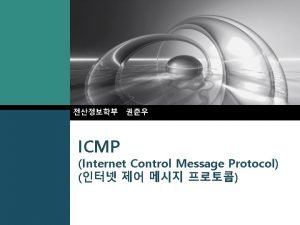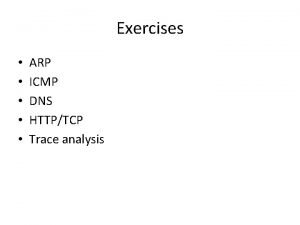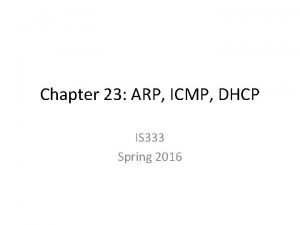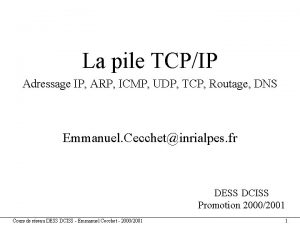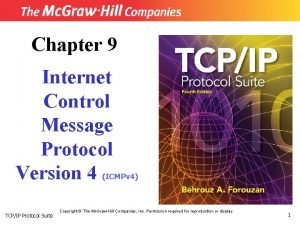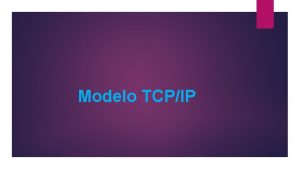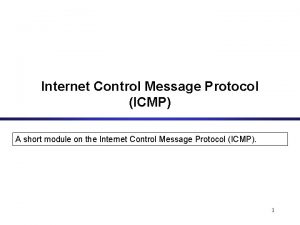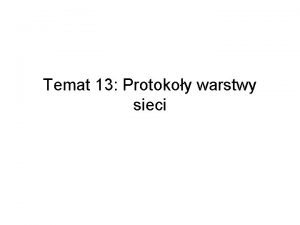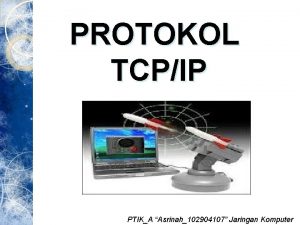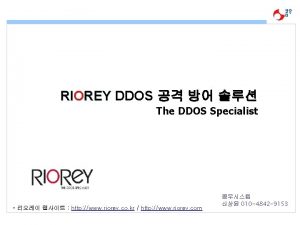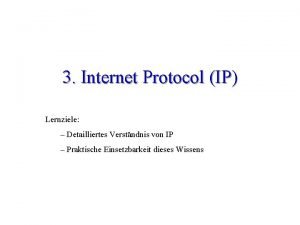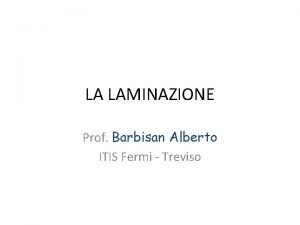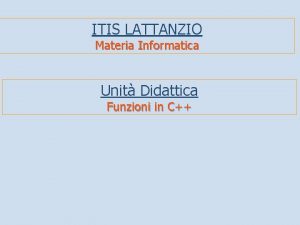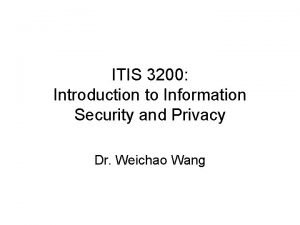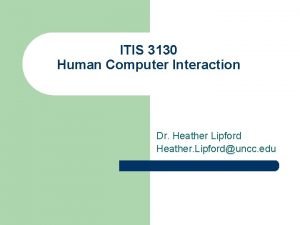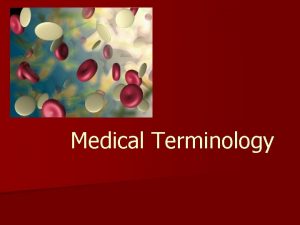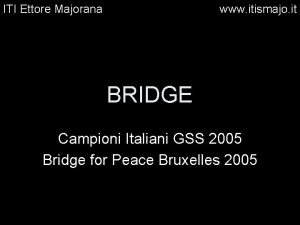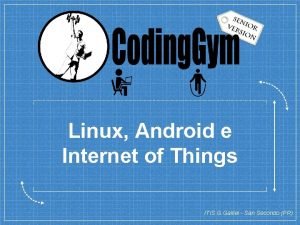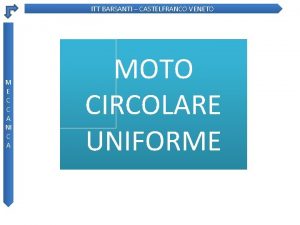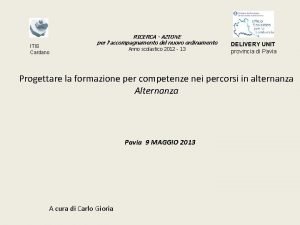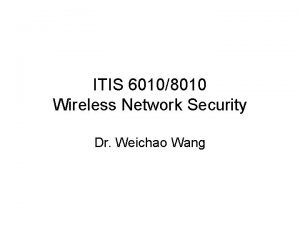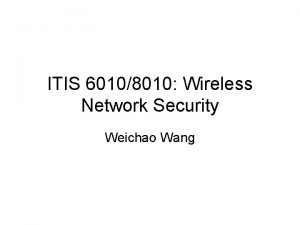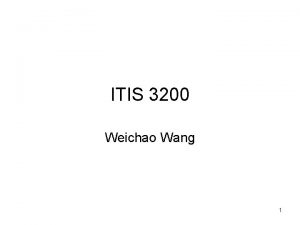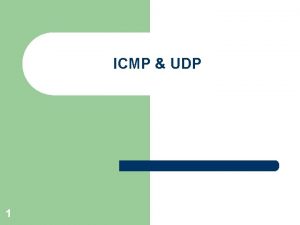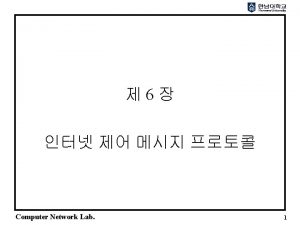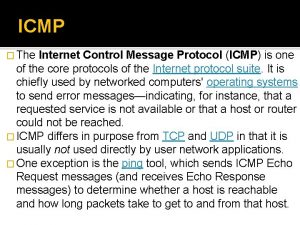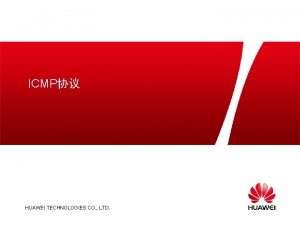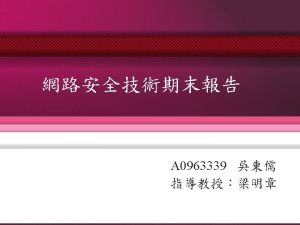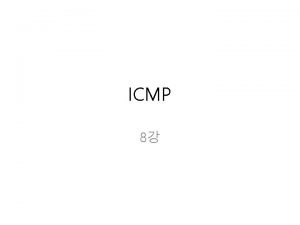ITIS 61678167 Network Security Weichao Wang Contents ICMP




























































- Slides: 60

ITIS 6167/8167: Network Security Weichao Wang

Contents • ICMP protocol and attacks • UDP protocol and attacks • TCP protocol and attacks 2

• TCP: Transmission Control Protocol – The most loved and hated protocol – Various protocols have been developed to replaced it, but not work very well 3

• The need for stream delivery – Out of order – Packet delay – Packet loss – Packet duplicate 4

• TCP’s properties – Stream orientation • TCP treats data as continuous flow of bytes • The sequence of the sent and received data are exactly the same – Virtual circuit connection – Buffered transfer • Application can determine the size of the pieces of the information it wants to transfer • Protocol software will divide the information into segments • Usually use a segment with a reasonable size • Can use “push” option to force transfer without buffering 5

• Unstructured stream – TCP does not honor structured data stream – It is the application’s responsibility to understand the data structure • Full duplex connection: transfer in both directions (can close one direction while keeping the other active) • Reliability – Positive acknowledgement with retransmission 6

• Layer structure 7

• TCP ports – TCP uses ports to identify applications – A connection is identified by four items • Source IP and protocol port number • Destination IP and protocol port number – A given TCP port number can be shared by multiple connections on the same machine because they will have different source IP and port numbers 8

• Reserved TCP port number – Port number can be 0 to 65535 – 0 to 1024 are reserved for well known services • • • 7: echo 13: Daytime 21: FTP 22: SSH 23: TELNET 25: SMTP 53: DNS 79: Finger 80: HTTP 9

• TCP segment format 10

• HLEN: length of segment header measured in 32 bits • Checksum: over (pseudo header, TCP data) 11

• CODE Bits: the purpose and contents of the segment 12

• Sliding window mechanism – Used for flow control – Operate at the byte level, instead of packet or segment level (why) – An example of the sliding window 13

14

• In the window: – Octets through 2 have been sent and acknowledged – Octets 3 to 6 have been sent but not acknowledged – Octets 7 to 9 have not been sent but can be sent – Octets 10 and above cannot be sent 15

• Receiver’s window: – Receiver maintains a window, it is different from the sender’s window – It indicates how many more bytes the receiver can accept – Bytes falling out of the window will be discarded 16

• TCP allows the window size to change over time – In each acknowledgement, the WINDOW size identifies how many more octets the receiver can accept. It can be viewed as the buffer size at the receiver side. – If the window size increases, the sender move the sliding window forward and send more octets – If the window size decreases, stop sending new bytes to the remote side. (not necessarily back move the window) – Window size can be 0 17

• Out of band data – TCP treats data like streams, what if we have some data of emergency and cannot wait till the end of the stream? – Example: Control-C to stop the program – Urgent code bit can be used to specify this kind of data – Urgent pointer: specify where the data ends 18

• Acknowledgement number: the next byte the receiver expects to receive – The ACK focuses on the continuous data that have been received. The isolated pieces will not be acknowledged. – There are versions supporting selective retransmission 19

• Timeout and retransmission – The packets can get lost because of various reasons – A timer will be started for every sent segment – If timer expires, we will resend the segment – Figuring out the appropriate timeout: • If it is too short, too many resend • If it is too long, cannot respond to packet lost properly 20

• Deriving the timeout – Measure the round trip time b/w the packet and ack – Using a weighted average value – Timeout = constant * RTT – How to handle resent packets? – There are tens of papers discussing this issue 21

• Congestion control – The sender and receiver windows only handle problems at the end points. Packet may get lost at the intermediate routers – TCP uses congestion window allowed win = min(receiver win, congestion win) – Routers drop packets when congestion happens, leading to retransmission 22

• Retransmission leads to worse congestion • To reduce congestion, TCP uses two methods – Multiplicative decrease congestion avoidance: when a packet loss happens, reduce the congestion window by half. Back off the retransmission timers for the packets still in window – Slow start recovery: for a new connection or after a congestion, start the window at one segment, increase the window by one segment after every received ack – Is this slow enough? ? ? 23

• Other schemes for congestion control – Congestion avoidance: after the congestion window reaches a threshold, add one segment after each RTT – Fast retransmission: resend packets when multiple ACK with the same ACK number received – Fast recovery: reduce the window to the threshold 24

• Silly window and countermeasures – The receiver’s window is full – It fetches one byte from the window every time and sends an ACK – One more byte will be sent from the sender – Very low efficiency – How to avoid silly window: • Receiver’s view • Sender’s view 25

• PUSH bit: forcing data delivery – If we are using TCP for an interactive terminal, holding data may lead to bad interfaces. User cannot see key stroke results. – TCP provides a PUSH bit to force data delivery without delay – The PUSH bit also tells the receiver to handle the data immediately 26

• Establishing TCP connection: 3 way hand shake • Three way hand shake accomplish two things: – Both sides ready for the transmission – Both sides agree the initial sequence number • Initial sequence number – Each machine should choose this at random – Non-random sequence has security problems 27

28

• Closing a TCP connection – TCP can close the connection in one direction by sending a FIN packet – Once the connection is closed, TCP will not accept more data. Data can still flow in the opposite direction. – When both ends close the connection, the resources can be released 29

30

• The above figure only illustrates the perfect world – Timed wait period in the state machine of TCP – For emergency condition, use connection RESET 31

• TCP Connection reset – Abnormal condition arise and we need to break the connection. – Send a segment with RST bit set – Both sides will cut the connection and release all the resources. – If not authenticated, can be used for attack. 32

33

• The problem of TCP connection over very high speed connection: – the Window size is too small. 34

35

• Attacks on TCP • SYN flood – The earliest Do. S attacks – Attacker sends the first SYN packet, initiates the connection – Never bother to send the ack – The victim allocates resources and maintains the halfopen connection for a duration of time (75 sec in many systems) – The SYN packets with spoofed IP source address 36

• The data falling out of the receiver’s window will be discarded. So guessing the current window is an important step for many attacks on TCP. – Inject invalid packet to the TCP connection – Blind reset attack • Security of Initial Sequence Number (ISN) – The attacker wants to know what the ISN is – If on the same network, sniff the packet – Otherwise, guess the sequence number 37

• Is it hard to guess the sequence? – It is a 32 bit number – If the window size is w, you need to send (2^32) / w packets. – If w = 16 K byte, you need to send (2^32) / (2^14) = 2^18 packet = 262 K pkt – If you can send out 4 K pkt/second, you will need about 65 seconds 38

• Initial window size for various OS and the packets needed to guess the sequence number – Win 2 K Sp 4, Win XP Sp 1: 64 K Byte (66 K pkt) – HP-UX 11: 32 K Byte (131 K pkt) – Nokia IPSO, Cisco IOS 12. x, Win 2 K Sp 1, Win 2 K Sp 3: 16 K Byte (262 K pkt) – Linux 2. 4. 28: 5. 8 K byte (735 K pkt) 39

• Windows 2 K, Linux, and Solaris: can adjust the initial window size 40

• Guess the source port: – Every TCP connection is labeled by two pairs of (IP, port number) – If the attack packet is not correctly labeled by the IP and port, it will be discarded – It is not too difficult to determine 3 out of the 4 parameters: • Destination IP and port number (server side) • Source IP (this is your victim) 41

• If the ports are randomly assigned at the source side, there are thousands of possibilities. • It will be very difficult for the attacker to correctly guess both valid window sequence and the port number: if identify sequence number needs 1 minute, now we need thousands of minutes. • So many scan packets can be easily identified • Most connections will not last for thousands of minutes 42

• Unfortunately, most OS allocate port numbers in order (Windows and Linux). Open. BSD starts to use random numbers since 1996. • Several examples of relationship b/w allocated port numbers – – Cisco IOS 12. x: add 1 or add 512 Windows 2000 and XP: add 1 Linux 2. 4. 18: add 1 Nokia IPSO: add 1 43

44

• ICMP attacks on TCP – ICMP error reporting packets contain the IP header and first 8 bytes of the original packet – Include the source port, destination port, and sequence number of TCP – How can we authenticate the packet – Several attacks • Blind connection reset • Blind throughput reduction • Blind performance degrading 45

• RFC 1122 classifies the ICMP error messages into those reporting “hard errors” and “soft errors” • ICMP has the source quench messages • RFC 1191 defines Path MTU discovery to figure out the MTU along a path. It uses (fragment needed but DF set) to figure this out. • ICMP for IPv 6 may still be vulnerable to some attacks 46

• RFC 1122 requires that TCP must respond to ICMP error messages • Thus, the source IP and port, and destination IP and port will be in the ICMP packet • No authentication methods are defined • Attacker can generate fake ICMP packets to impact TCP connections 47

• Possible solutions and their restraints – RFC 1812 says that “ICMP message should contain as much information as possible from the original packet as long as it is not longer than 576 bytes” – The original IP packet cannot be authenticated if we do not have the whole packet – Authentication b/w • End nodes • End node and routers 48

• TCP should check the following fields in the original IP packet causing the ICMP message before taking action – TCP sequence number (already implemented in Linux, Open. BSD, Free. BSD, and Net. BSD) – TCP port randomization – Ingress and egress packet filtering 49

50

• Blind connection reset attack • TCP handles ICMP error reports as follows: – If it is a hard error, abort the connection – If it is a soft error, retransmit data until connection timeout 51

• In RFC 1122, it says – ICMP type 3 (destination unreachable), code 2 (protocol unreachable), code 3 (port unreachable), and code 4 (fragment but DF) are all hard errors – Attacker can use these ICMP messages to reset TCP connections even when they are off path – Some OS will extrapolate ICMP errors across TCP connections. And multiple connections can be impacted by a single ICMP packet 52

• Countermeasures – Reconsider the “hard” errors • Type 3, code 2 (protocol unreachable) should appear during the establishment procedure. Otherwise, treated as a soft error • Type 3, code 3 (port unreachable) should also be treated as soft errors if TCP has its own methods to handle port listening problems • Type 3, code 4 (fragment but DF): do not set this bit unless you have already figure out the MTU on the path • Implemented in Free. BSD, Open. BSD, Net. BSD, and Linux 53

• Delay the connection reset – Delay the reset until the packet has been received for a certain amount of time, and the data packets have been retransmitted for a certain number of times. (the idea is that if we are making progresses, there is no hard errors. ) 54

55

• Blind Throughput reduction – RFC 1122 requires nodes to react to source quench ICMP messages – Some OS will use slow start and set the size to one segment – Now we send one packet every RTT, the throughput is low 56

• Countermeasures – RFC 1812 shows that source quench is ineffective to congestion – TCP has its own congestion control – Solution: ignore source quench ICMP – Linux, Free. BSD, Open. BSD, and Net. BSD adopt this since 2004 and 2005. 57

58

• Blind performance degrading attack – We can use (fragment but DF) to detect the path MTU – Attacker can use this ICMP message to attack TCP by sending a very small MTU value – Now the performance is impacted since the header/data ratio changes – If the MTU is set too small, no data can be actually sent 59

• Countermeasures – A method similar to the “delayed reset” will be used – The MTU will change only when the packet has been retransmitted for a certain number of times – Implemented in Open. BSD and Net. BSD since 2005 60
 Private secuirty
Private secuirty Osi security architecture in hindi
Osi security architecture in hindi Guide to network security
Guide to network security Wireless security in cryptography
Wireless security in cryptography Electronic mail security in network security
Electronic mail security in network security Security guide to network security fundamentals
Security guide to network security fundamentals Security guide to network security fundamentals
Security guide to network security fundamentals Tcp udp icmp
Tcp udp icmp Icmp type 8 code 0
Icmp type 8 code 0 Icmp redirect messages
Icmp redirect messages Icmpv
Icmpv Sequence number
Sequence number Icmp in computer networks
Icmp in computer networks Udp header
Udp header Dhcp icmp
Dhcp icmp Egp protocol
Egp protocol Wireshark icmp lab
Wireshark icmp lab Difference mib and mb
Difference mib and mb Icmp subtypes
Icmp subtypes Icmp canvas
Icmp canvas Ping 172
Ping 172 Icmp logo
Icmp logo Arp icmp
Arp icmp Dhcp icmp
Dhcp icmp Arp icmp
Arp icmp During error reporting, icmp always reports error messages
During error reporting, icmp always reports error messages Modeli tcp/ip
Modeli tcp/ip Icmp protocol header
Icmp protocol header Warstwy sieci
Warstwy sieci Pengertian protokol adalah... *
Pengertian protokol adalah... * Cpstcp
Cpstcp Ip header vs tcp header
Ip header vs tcp header Arca dei suoni
Arca dei suoni Iti fermi treviso
Iti fermi treviso Itis lattanzio
Itis lattanzio Itis da vinci lanciano
Itis da vinci lanciano Tassinari pozzuoli
Tassinari pozzuoli Itis 3200
Itis 3200 Itis 3130
Itis 3130 Objective in medical terms
Objective in medical terms La moneta
La moneta I.t.i. ”e. majorana” di grugliasco
I.t.i. ”e. majorana” di grugliasco Itis majorana grugliasco
Itis majorana grugliasco Pacinotti scafati
Pacinotti scafati Itis volta perugia
Itis volta perugia Liceo cardano pavia
Liceo cardano pavia Itis g marconi pontedera
Itis g marconi pontedera Itis pinin
Itis pinin Itt barsanti
Itt barsanti Itis pozzuoli
Itis pozzuoli Iti galileo galilei livorno
Iti galileo galilei livorno Itis cardano
Itis cardano Pacinotti scafati
Pacinotti scafati Itis benedetto castelli
Itis benedetto castelli Focaccia salerno
Focaccia salerno Itis grugliasco
Itis grugliasco Itis planck
Itis planck Istituto cardano pavia
Istituto cardano pavia Itis pininfarina
Itis pininfarina Itis morosini
Itis morosini Cardano itis
Cardano itis







